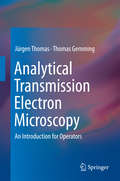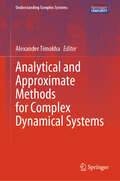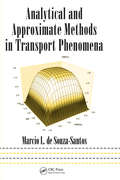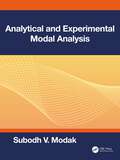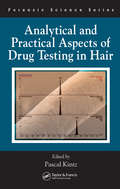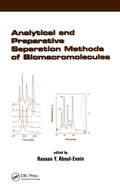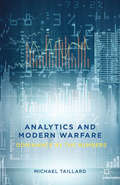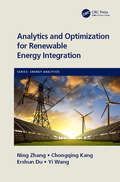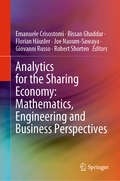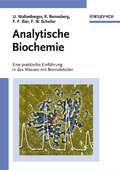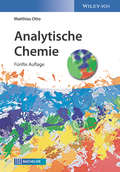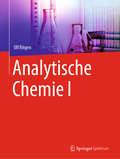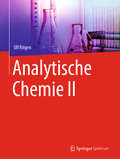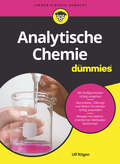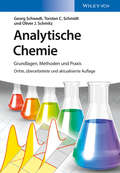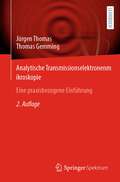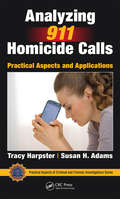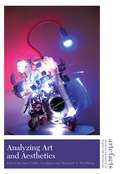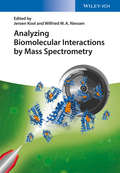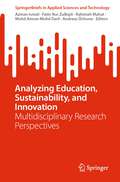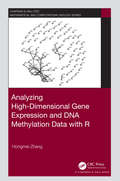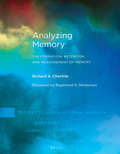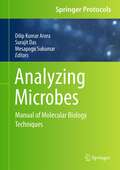- Table View
- List View
Analytical Transmission Electron Microscopy: An Introduction for Operators
by Jürgen Thomas Thomas GemmingThis work is based on experiences acquired by the authors regarding often asked questions and problems during manifold education of beginners in analytical transmission electron microscopy. These experiences are summarised illustratively in this textbook. Explanations based on simple models and hints for the practical work are the focal points. This practically- oriented textbook represents a clear and comprehensible introduction for all persons who want to use a transmission electron microscope in practice but who are not specially qualified electron microscopists up to now.
Analytical and Approximate Methods for Complex Dynamical Systems (Understanding Complex Systems)
by Alexander TimokhaThis book presents Analytical and Approximate Methods for Complex Dynamical Systems and introduces ideas of discontinuous mapping treated as complex dynamical systems. Mathematicians of world-recognized Ukrainian scientific schools established by M.Krylov, M.Bogolyubov, Yu.Mitropolskiy, and A.Sharkovsky used to cooperate for writing the collective book whose purpose consists of illustrating a synergy of combining diverse (by idea and technique) constructive analytical and approximate approaches and methods in complex dynamical systems which are herein associated with mathematical models of networks, conflict/economic theories, sloshing, soft matter, and even levitating drops. Readers are facilitated to learn contemporary insights, fundamentals (Parts I and III), applications (Part II), and components of theories of bifurcation, synchronization/self-organization, collective dynamics, chaos, solitons, fractional differential equations, symmetry, reduced order modelling, and many others, that makes the book useful for both graduate and postgraduate students, lecturers, researchers, and even engineers dealing with multidimensional dynamic systems.
Analytical and Approximate Methods in Transport Phenomena
by Marcio L. de Souza-SantosOn the job or in the field, when facing a problem with differential equations and boundary conditions, most likely you don't have time to read through several publications in search of a method that may or may not solve your problem. Organized for quick and easy access to practical solutions, Analytical and Approximate Methods in Transport Pheno
Analytical and Experimental Modal Analysis
by Subodh V. ModakThis book covers the fundamentals and basic concepts of analytical and experimental approaches to modal analysis. In practice, the analytical approach based on lumped parameter and finite element models is widely used for modal analysis and simulation, and experimental modal analysis is widely used for modal identification and model validation. This book is inspired by this consideration and is written to give a complete picture of modal analysis. Features: Presents a systematic development of the relevant concepts and methods of the analytical and experimental modal analyses. Covers phase resonance testing and operational modal analysis. Provides the relevant signal processing concepts. Includes applications like model validation and updating, force identification and structural modification. Contains simulations, examples, and MATLAB® programs to enhance understanding. This book is aimed at senior undergraduates/graduates, researchers, and engineers from mechanical, aerospace, automotive, civil, and structural engineering disciplines.
Analytical and Practical Aspects of Drug Testing in Hair (International Forensic Science and Investigation)
by Pascal KintzWritten by well-known, international authors, this comprehensive reference provides practical coverage of the best hair drug testing techniques and examines the drugs themselves. The authors review all new developments, the validation of analytical procedures, and the interpretation of data. Some of the applications discussed include doping, drug-facilitated crime investigating, workplace testing, and the granting of drivers' licenses. The authors describe specific drugs, such as opiates, cocaine, and cannabis, and discuss the different testing methods of them. The book also covers postmortem toxicology, pitfalls created by passive exposure, and testing for metals, including inductively coupled plasma spectrometry (ICP-MS), hair multielemen
Analytical and Preparative Separation Methods of Biomacromolecules
by Hassan Y. Aboul-EneinReports up-to-date research developments on purifying and isolation large organic molecules. The text provides information on high-performance liquid chromatography and capillary electrophoresis (CE) as tools for analyzing biomacromolecules and developing new biochemical and medicinal compounds. It applies biochemical separation technology to the study of macromolecules such as proteins, polysaccharides, nucleic acids and more.
Analytical or Semi-analytical Solutions of Functionally Graded Material Structures
by Zheng Zhong Guojun NieThis book provides a comprehensive introduction to the analysis of functionally graded materials and structures. Functionally graded materials (FGMs), in which the volume fractions of two or more constituent materials are designed to vary continuously as a function of position along certain direction(s), have been developed and studied over the past three decades. The major advantage of FGMs is that no distinct internal boundaries exist, and failures from interfacial stress concentrations developed in conventional components can be avoided. The gradual change of material properties can be tailored to different applications and working environments. As these materials’ range of application expands, new methodologies have to be developed to characterize them, and to design and analyze structural components made of them.Despite a number of existing papers on the analysis of functionally graded materials and structures, there is no single book that is devoted entirely to the analysis of functionally graded beams, plates and shells using different methods, e.g.,analytical or semi-analytical methods.Filling this gap in the literature, the book offers a valuable reference resource for senior undergraduates, graduate students, researchers, and engineers in this field. The results presented here can be used as a benchmark for checking the validity and accuracy of other numerical solutions. They can also be used directly in the design of functionally graded materials and structures.
Analytics And Modern Warfare: Dominance by the Numbers
by Michael TaillardThis book details very simply and for even the most novice of potential analysts not only how to perform analytics which describe what is happening, predict what is going to happen, and optimize responses, but also places these analytics in the context of proactive strategy development.
Analytics and Optimization for Renewable Energy Integration (Energy Analytics)
by Ning Zhang Yi Wang Chongqing Kang Ershun DuThe scope of this book covers the modeling and forecast of renewable energy and operation and planning of power system with renewable energy integration.The first part presents mathematical theories of stochastic mathematics; the second presents modeling and analytic techniques for renewable energy generation; the third provides solutions on how to handle the uncertainty of renewable energy in power system operation. It includes advanced stochastic unit commitment models to acquire the optimal generation schedule under uncertainty, efficient algorithms to calculate the probabilistic power, and an efficient operation strategy for renewable power plants participating in electricity markets.
Analytics for the Sharing Economy: Mathematics, Engineering and Business Perspectives
by Giovanni Russo Emanuele Crisostomi Robert Shorten Bissan Ghaddar Florian Häusler Joe Naoum-SawayaThe book provides an encompassing overview of all aspects relating to the sharing economy paradigm in different fields of study, and shows the ongoing research efforts in filling previously identified gaps in understanding in this area. Control and optimization analytics for the sharing economy explores bespoke analytics, tools, and business models that can be used to help design collaborative consumption services (the shared economy). It provides case studies of collaborative consumption in the areas of energy and mobility.The contributors review successful examples of sharing systems, and explore the theory for designing effective and stable shared-economy models. They discuss recent innovations in and uses of shared economy models in niche areas, such as energy and mobility. Readers learn the scientific challenging issues associated with the realization of a sharing economy. Conceptual and practical matters are examined, and the state-of-the-art tools and techniques to address such applications are explained. The contributors also show readers how topical problems in engineering, such as energy consumption in power grids, or bike sharing in transportation networks, can be formulated and solved from a general collaborative consumption perspective. Since the book takes a mathematical perspective to the topic, researchers in business, computer science, optimization and control find it useful. Practitioners also use the book as a point of reference, as it explores and investigates the analytics behind economy sharing.
Analytische Biochemie: Eine praktische Einfuhrung in das Messen mit Biomolekulen
by Frank F. Bier Ulla Wollenberger Reinhard Renneberg Frieder W. SchellerZur Lösung analytischer Fragestellungen wird in der Biotechnologie, der Lebensmittel- und Umweltanalytik sowie der klinischen und pharmazeutischen Chemie neben der instrumentellen Analytik immer häufiger auf bioanalytische Methoden zurückgegriffen. Diese beruhen z. B. auf dem Einsatz von Enzymen, Nukleinsäuren oder Antikörpern. Dazu bietet das Buch eine praktische Einführung in die qualitative und quantitative Analytik mit biochemischen Reagenzien, die sowohl für das Studium wie für die Weiterbildung im Beruf geeignet ist. Die Autoren schlagen eine Brücke von den theoretischen Grundlagen hin zu den praktischen Anwendungen. Dem vertieften Verständnis dient die Beschreibung erprobter Praktikumsversuche. Die Autoren gehören zu einer der weltweit führenden Forschungsgruppen auf diesem Gebiet, lassen aber auch ihre langjährige Lehrerfahrung in dieses neue Buch einfließen.
Analytische Chemie
by Matthias OttoDer "Otto" hat sich zu einem Standardwerk für Studenten der Chemie, Pharmazie, Lebensmittelchemie und anderer chemischer Disziplinen entwickelt, das auch von Nicht-Chemikern und Chemieingenieuren wegen seines didaktischen Aufbaus und seiner klaren Darstellung geschätzt wird. In fünfter, nochmals aktualisierter und um neueste Analysemethoden ergänzter Auflage, wird das gesamte Analytik-Wissen auf Bachelor-Niveau dargestellt. Mit dem Blick für das Wesentliche erklärt der Autor, worauf es bei den vielen heute gebräuchlichen Analysemethoden wirklich ankommt. Von den Grundlagen der qualitativen und quantitativen Analyse bis zu modernen Hochdurchsatz-Analysegeräten und der Qualitätssicherung wird die gesamte Bandbreite der modernen Analytik vorgestellt. Die fünfte Auflage bietet noch mehr Aufgaben und Lösungen zur Selbstkontrolle, außerdem zahlreiche Beispielrechnungen. Die Begriffe und Konstanten sind nach harmonisierten IUPAC-Definitionen aktualisiert. Eine blaue Schmuckfarbe wird im Buch verwendet, um einen noch effizienteren Lernprozess zu ermöglichen.
Analytische Chemie I
by Ulf RitgenDas Arbeitsbuch führt durch das erfolgreiche Werk Harris, Lehrbuch der Quantitativen Analyse und ist vor allem für das Selbststudium konzipiert. In fünf Teilen werden die Vorlesungsinhalte der Analytischen Chemie zusammengefasst und anhand ausgewählter Beispiele erläutert. Grundbegriffe der Analytik werden ebenso dargelegt wie das Prinzip und die verschiedenen Techniken der Maßanalyse und der Chromatographie. Anhand von UV/VIS-, Infrarot- und Raman-Spektroskopie wird die Untersuchung molekular vorliegender Verbindungen erklärt, mit ausgewählten Techniken der Atomspektroskopie findet die Einführung in die Grundlagen der Analytik ihren Abschluss. Dabei wird immer wieder auf essenzielle Abschnitte und Abbildungen des Lehrbuches verwiesen, was das selbstständige Lernen der Grundlagen der Analytischen Chemie erleichtert.Leicht lesbar führt das Buch in die Grundlagen und die wichtigsten Techniken der Analytischen Chemie ein; es richtet sich an Studierende im Grundstudium der Chemie oder verwandter naturwissenschaftlicher Fächer. Dabei wird immer wieder auf die aus Lehrveranstaltungen der Allgemeinen Chemie bekannten Grundlagen Rückbezug genommen, sodass die Zusammenhänge zwischen bereits Bekanntem und Neuem sofort erkenntlich werden. Das Lernen mit diesem Arbeitsbuch ist in einem Fernstudiengang Chemie erprobt und erleichtert die Vorbereitung auf Modulprüfungen der Analytischen Chemie.
Analytische Chemie II
by Ulf RitgenDieses Arbeitsbuch führt durch das erfolgreiche Lehrbuch Skoog/Holler/Crouch, Instrumentelle Analytik und ist vor allem für das Selbststudium konzipiert.In fünf Teilen werden die Vorlesungsinhalte der fortgeschritteneren Analytischen Chemie zusammengefasst und anhand ausgewählter Beispiele erläutert: Mit der Untersuchung von Molekülen befassen sich Massenspektrometrie und Kernresonanzspektroskopie, zudem werden zahlreiche elektroanalytische Methoden wie Potentiometrie, Coulometrie, Amperometrie und Voltammetrie behandelt. In einem Überblick über speziellere Verfahren der Analytik geht es unter anderem ebenso um den Einsatz radioaktiver Substanzen und die Nutzung verschiedener Fluoreszenzverfahren wie um Methoden der Informationsgewinnung in der zunehmend wichtigen elektrochemischen und optischen Sensortechnik sowie deren Automatisierbarkeit. Den Abschluss bildet eine Zusammenfassung verschiedener Prinzipien und Anwendungsmethoden der Statistik, die im Rahmen der Analytik schlichtweg unverzichtbar sind. Um das selbstständige Lernen zu erleichtern, wird dabei in allen Teilen des Buches immer wieder auf essenzielle Abschnitte und Abbildungen des Lehrbuches verwiesen.Nicht zuletzt aufgrund der zahlreichen Beispiele führt das Buch, das sich an Studierende der Chemie oder verwandter naturwissenschaftlicher Fächer richtet, leicht nachvollziehbar auch in komplexere Aspekte der Analytischen Chemie ein. Dabei wird in direkter Fortführung des Arbeitsbuches Analytische Chemie I immer wieder auf bereits bekannte Grundlagen aus anderen Lehrveranstaltungen verwiesen, die das Verknüpfen von Vertrautem und Neuem erleichtern. Das Lernen mit diesem Arbeitsbuch ist in einem Fernstudiengang Chemie erprobt und erleichtert die Vorbereitung auf Modulprüfungen der fortgeschritteneren Analytischen Chemie.
Analytische Chemie für Dummies (Für Dummies)
by Ulf RitgenDie Analytik ist zwar ein grundlegendes Thema innerhalb der Chemie, hat es aber ganz schön in sich. Aber keine Sorge, Ulf Ritgen erklärt Ihnen in diesem Buch was Sie zur Analytischen Chemie Wissen sollten. Wie erhält man eigentlich analytische Infos? Welche Standards gibt es? Und wie sollte man überhaupt mit den Stoffgemischen umgehen? All diese Grundlagen werden ausführlich erläutert. Aber auch die Anwendungsgebiete und Methoden kommen keinesfalls zu kurz. Egal ob Gravimetrie, Titration, Fällung oder Konduktometrie, endlich wird alles verständlich erklärt. Jetzt können Prüfung und Praktikum kommen!
Analytische Chemie: Grundlagen, Methoden und Praxis
by Georg Schwedt Oliver J. Schmitz Torsten C. SchmidtAlle relevanten Aspekte der Analytischen Chemie werden in diesem Lehrbuch, das gleichzeitig auch als Referenz fur Praktiker dient, umfassend und klar auf den Punkt gebracht. Das Autorenteam wird durch zwei aktive und international bekannte Professoren verstarkt; dies sorgt fur frischen Wind, gleichzeitig wird der didaktisch ausgefeilte Stil der Vorauflagen beibehalten. Von der Analysenstrategie zur Probenvorbereitung, von der Ma?analyse uber spektroskopische und chromatographische Methoden bis zur Automatisierung - DAS Lehrbuch fur alle, die sich mit Analytischer Chemie beschaftigen.
Analytische Transmissionselektronenmikroskopie: Eine praxisbezogene Einführung
by Jürgen Thomas Thomas GemmingDas Buch wendet sich an alle, egal ob im Studium, in technischen Berufen, oder in der Wissenschaft, die die sich für die analytische Transmissionselektronenmikroskopie interessieren und einen Überblick über diese Methode erhalten möchten. Insbesondere betrifft dies Personen, die an einem Transmissionselektronenmikroskop arbeiten wollen oder müssen, die aber noch keine spezielle elektronenmikroskopische Ausbildung durchlaufen haben. Das Buch basiert auf den Erfahrungen der Autoren bei der Unterrichtung von Studierenden, Promovierenden und in technischen Berufen Tätigen. Der Überblick über die analytische Transmissionselektronenmikroskopie umfasst die Schwerpunkte Optische Abbildung, Elektronenwellen, magnetische Linsen, Abbildungsfehler, Aufbau eines Transmissionselektronenmikroskops, Präparation dünner Proben, Justage des Mikroskops, Elektronenbeugung, Kontrastentstehung, Höchstauflösungselektronenmikroskopie, Rastertransmissionselektronenmikroskopie sowie Analytik mittels energiedispersiver Röntgenspektroskopie und Elektronenenergieverlust-Spektroskopie. Ein mathematischer Anhang erklärt grundlegende Formalismen zur Thematik.
Analyze This! Understanding the Scientific Method
by Susan GlassHow did Walter Reed solve the mystery of yellow fever? Will balls of different masses fall at the same speed? Is your cat right-pawed or left-pawed? The world around us is full of interesting questions. This series gives students the tools to find the answers! Students will discover how the scientific method has changed our lives, and will learn how to plan, design, and conduct their own investigations.
Analyzing 911 Homicide Calls: Practical Aspects and Applications (Practical Aspects of Criminal and Forensic Investigations)
by Tracy Harpster Susan H. AdamsThis book provides police investigators and homicide detectives with a practical method of analyzing 911 homicide calls to uncover the truth. A structured analysis of 911 homicide calls can directly aid in developing investigative leads, planning interviews and solving cases. Case examples present proven, reliable methods as to when a caller is telling the truth or not. This book lays out a framework to analyze the call to determine truth from fiction. Every member of the investigative team, from call-taker to first responder, investigator, coroner’s investigators, and prosecutor, can contribute to the success of investigations through their knowledge of 911 call analysis.
Analyzing Art and Aesthetics (Artefacts: Studies in the History of Science and Technology #9)
by Margaret A. Weitekamp Anne Collins GoodyearThis ninth volume of the Artefacts series explores how artists have responded to developments in science and technology, past and present. Rather than limiting the discussion to art alone, editors Anne Collins Goodyear and Margaret Weitekamp also asked contributors to consider aesthetics: the scholarly consideration of sensory responses to cultural objects. When considered as aesthetic objects, how do scientific instruments or technological innovations reflect and embody culturally grounded assessments about appearance, feel, and use? And when these objects become museum artifacts, what aesthetic factors affect their exhibition? Contributors found answers in the material objects themselves. This volume reconsiders how science, technology, art, and aesthetics impact one another.
Analyzing Biomolecular Interactions by Mass Spectrometry
by Jeroen Kool Wilfried M. NiessenThis monograph reviews all relevant technologies based on mass spectrometry that are used to study or screen biological interactions in general. Arranged in three parts, the text begins by reviewing techniques nowadays almost considered classical, such as affinity chromatography and ultrafiltration, as well as the latest techniques. The second part focusses on all MS-based methods for the study of interactions of proteins with all classes of biomolecules. Besides pull down-based approaches, this section also emphasizes the use of ion mobility MS, capture-compound approaches, chemical proteomics and interactomics. The third and final part discusses other important technologies frequently employed in interaction studies, such as biosensors and microarrays. For pharmaceutical, analytical, protein, environmental and biochemists, as well as those working in pharmaceutical and analytical laboratories.
Analyzing Education, Sustainability, and Innovation: Multidisciplinary Research Perspectives (SpringerBriefs in Applied Sciences and Technology)
by Andreas Öchsner Azman Ismail Mohd Amran Mohd Daril Fatin Nur Zulkipli Rahimah MahatThis book describes a diverse array of studies unravelling the intricate interplay of education, sustainability, and organizational dynamics. From innovative teaching methodologies to sustainability trends and the pandemic's impact, this compendium offers a rich tapestry of insights. This book traverses through a compendium of studies that intricately dissect the synergy between education, sustainability, and organizational dynamics. This book is ideal for academics, practitioners, and curious minds seeking a deeper understanding of these vital contemporary forces.
Analyzing High-Dimensional Gene Expression and DNA Methylation Data with R (Chapman And Hall/crc Computational Biology Ser.)
by Hongmei ZhangAnalyzing high-dimensional gene expression and DNA methylation data with R is the first practical book that shows a ``pipeline" of analytical methods with concrete examples starting from raw gene expression and DNA methylation data at the genome scale. Methods on quality control, data pre-processing, data mining, and further assessments are presented in the book, and R programs based on simulated data and real data are included. Codes with example data are all reproducible. Features: • Provides a sequence of analytical tools for genome-scale gene expression data and DNA methylation data, starting from quality control and pre-processing of raw genome-scale data. • Organized by a parallel presentation with explanation on statistical methods and corresponding R packages/functions in quality control, pre-processing, and data analyses (e.g., clustering and networks). • Includes source codes with simulated and real data to reproduce the results. Readers are expected to gain the ability to independently analyze genome-scaled expression and methylation data and detect potential biomarkers. This book is ideal for students majoring in statistics, biostatistics, and bioinformatics and researchers with an interest in high dimensional genetic and epigenetic studies.
Analyzing Memory: The Formation, Retention, and Measurement of Memory (The\mit Press Ser.)
by Richard A. ChechileAn accessible synthesis of memory research that discusses the creation of memory representations, the processes of storage and retrieval, and the effectiveness of encoding information.The field of memory research is subdivided into many separate and non-overlapping topic areas that often employ specialized tools and models. This book offers an accessible synthesis of memory research that explores how memory works, how it is organized, and how it changes dynamically. Written by an expert in the field, it can be used by undergraduate and graduate students of psychology and as a reference by researchers who want to fill in gaps in their knowledge. The book focuses on three general topics that cover a vast amount of research in the field: how a memory representation is created, how the cognitive processes of storage and retrieval can be studied and measured, and the process of encoding information and its varying degrees of effectiveness. Specific subjects addressed include habituation and sensitization, and the neurobiological changes that underlie them; evidence for a cognitive component underlying Pavlovian conditioning; biological constraints on a cognitive model of memory; an information-processing framework for memory; misconceptions about memory, including the static memory myth and the permanent memory myth; model-based measurement of storage and retrieval processes; a critique of the concept of memory strength; the distinction between implicit and explicit memory; and learning and repetition. Although the writing is accessible to the nonspecialist, the density of information is high. The text avoids jargon, and a glossary defines key terms. The notes expand on technical details and point to interesting related ideas.
Analyzing Microbes: Manual of Molecular Biology Techniques (Springer Protocols Handbooks)
by Dilip Kumar Arora Surajit Das Mesapogu SukumarThis Springer Protocols manual is a practical guide to the application of key molecular biology techniques in microbiological research. The focus is on experimental protocols, which are presented in an easy-to-follow way, as step-by-step procedures for direct use in the laboratory. Notes on how to successfully apply the procedures are included, as well as recommendations regarding materials and suppliers. In addition to the practical protocols, important background information and representative results of experiments using the described methods are presented. Researchers in all areas applying microbial systems, such as in molecular biology, genetics, pathology, and agricultural research will find this work of great value.
